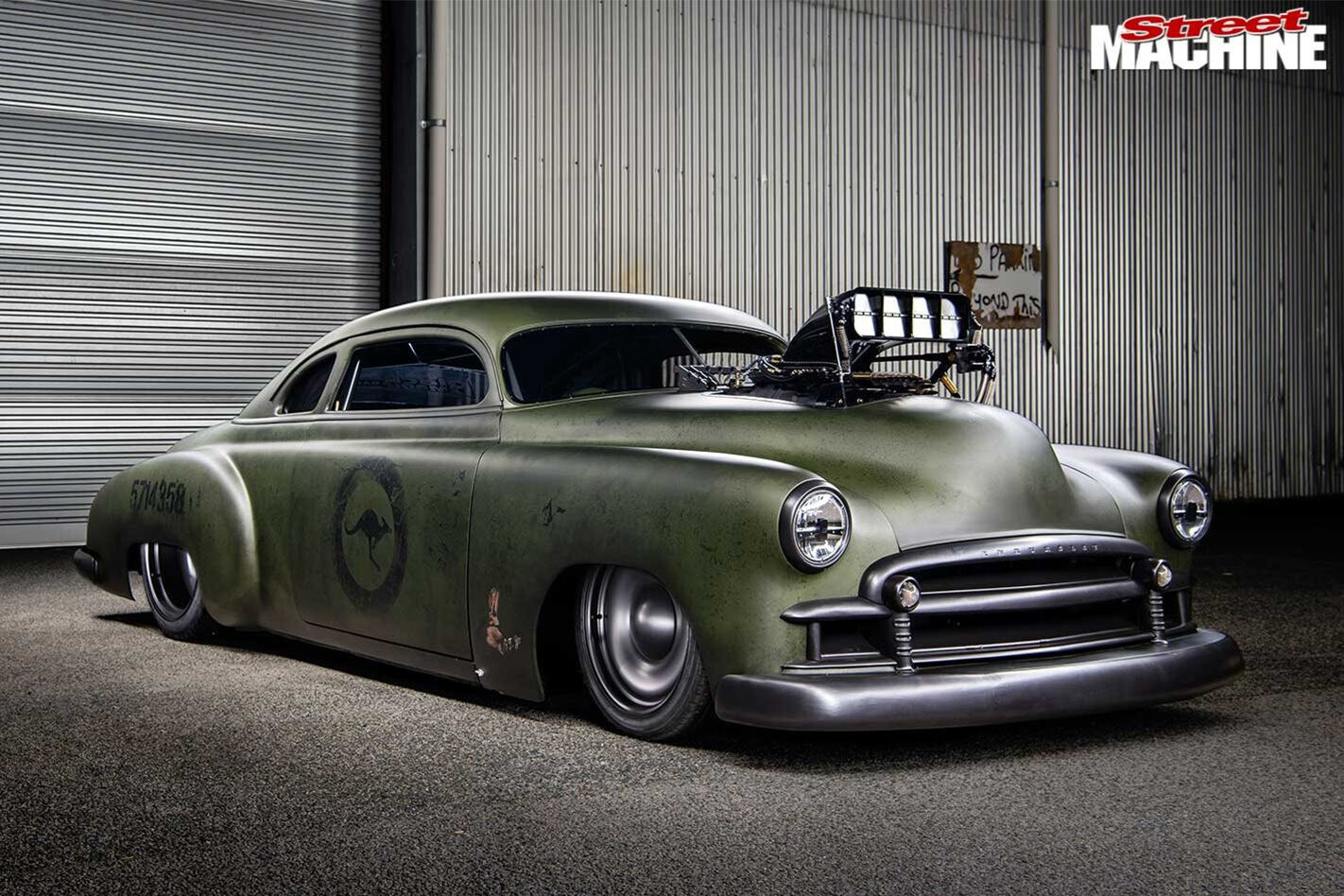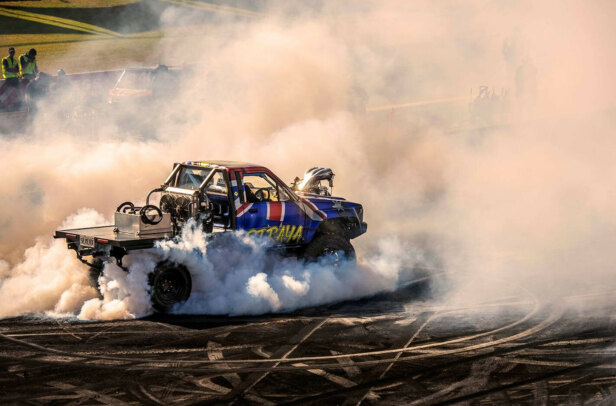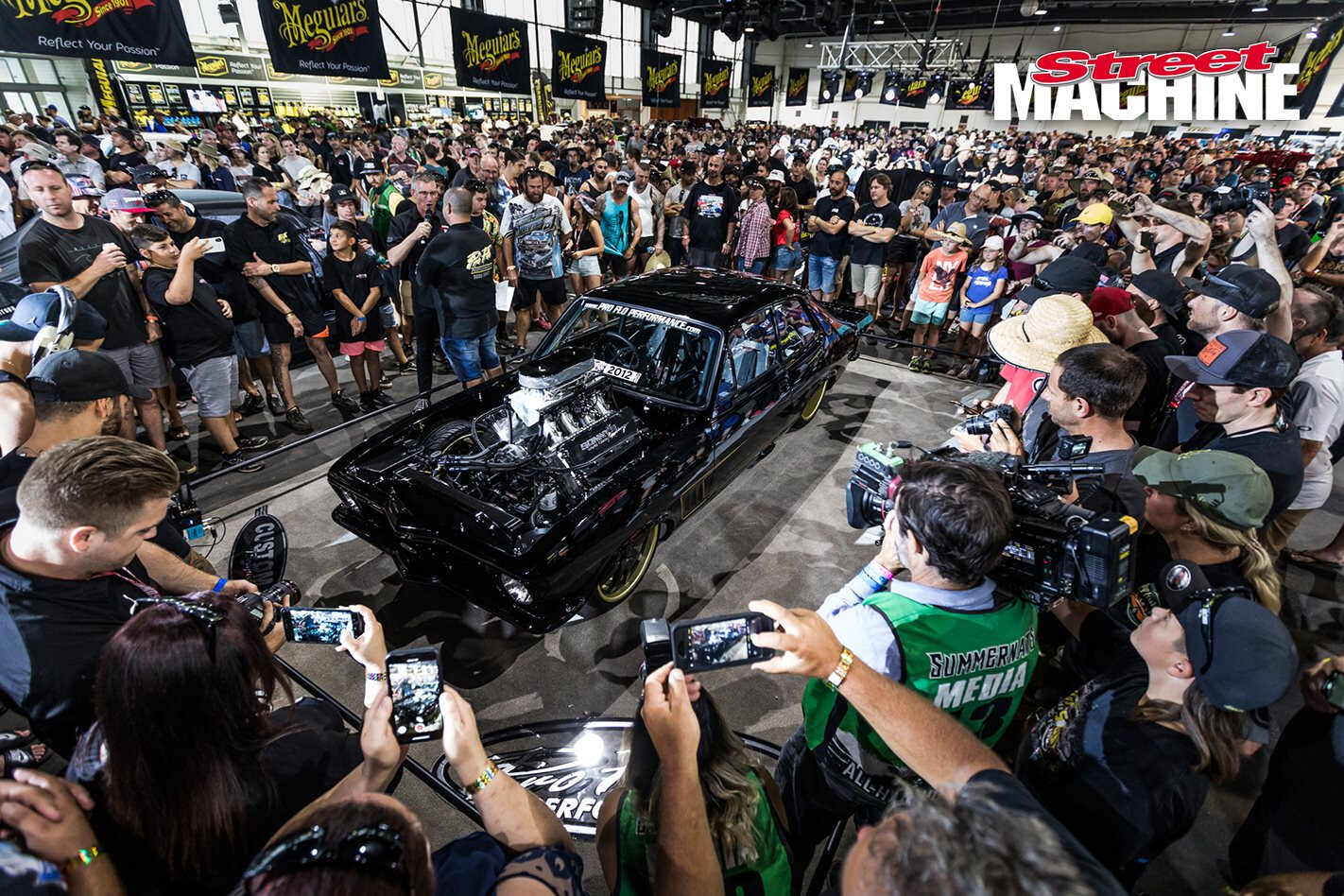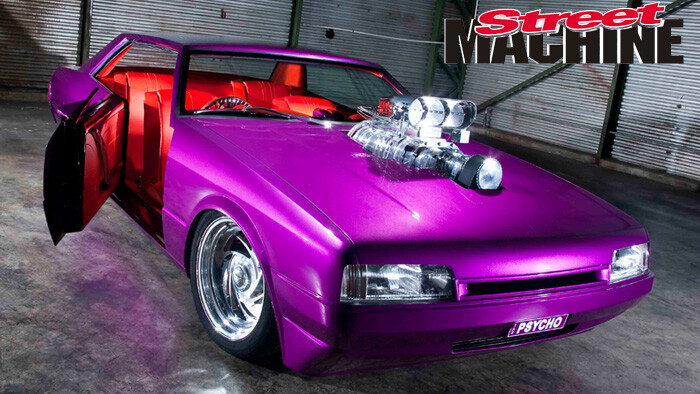ONE of the biggest hits at Street Machine Summernats 33 was Kevin and Jo Mantach’s army-themed ’50 Chevy coupe – partially because it was completely different to anything else at the event, but also because it is an exceedingly cool build with a tonne of clever touches and design features. While the prevailing trend of burnout car builds over the past few years has been turning the newest car you can find into a tyre-destroyer, Kev has flipped that on its head with one of the earliest cars built to this level.
This article was first published in the March 2020 issue of Street Machine
“Kev really wanted machine-gun tailpipes, so I said: ‘Leave it with me; I’ll see what I can come up with,’” says Blacky
While all manner of cars have been built over the years with an army theme, more often than not they have USA markings – a white star on the door, for instance – but not this time. Instead, Kev’s inspiration comes from his dad’s service in Vietnam with the Australian Army, so there’s a kangaroo roundel on the door, and emblazoned on the rear guards is his dad’s dog-tag number. The finish makes the car look like a battle-weary veteran that’s been dragged out of the jungle, with flaking and faded olive-drab paint and weathered markings, but it’s actually a very cleverly designed wrap by Ben and his team at SignBiz WA.
Viewing the car in profile, you can see how nicely proportioned the roof chop is. The slanted pillars are a nice touch, too, and the slammed stance is thanks to Ridetech airbags
Of course, you can’t just chuck in a big engine and slap a wrap over a beat-up old car and call it done, and that’s most definitely not what happened here. The entire car was built by Geoff and Lauren Black, the father/daughter team that make up Black Magic Race Cars (BMRC). According to the more senior Blacky, “nothing is a problem; there are only solutions, my friend.” The car is proof of that, with many challenges faced and overcome.
The front panels were bolted together and the whole lot slides and tilts for easy engine access. Behind the front wheel you can see one of the car’s four pneumatic lift jacks
One part of the car they didn’t have to worry about at all was the roof chop. “Whoever chopped it was obviously old school; it’s a very, very good job,” Blacky says. “When you look inside the roof you can see what was done.” As there is no roof lining in the car, that fine metalwork can still be viewed if you ever get the chance to stick your head inside the cabin.
Personally, I’m amazed the car didn’t get snapped up by someone and turned into a traditional 50s-style custom. The chop on it is absolutely spot-on. “That’s what caught my eye when I first saw it; I just loved the shape. You just don’t see them around here,” says Kev.
Around 90 hours went into the design of the wrap, which looks for all the world like a faded and peeling army-green paintjob. The team at SignBiz WA did four test wraps before applying the final product
The chop is about the only part of the car that wasn’t changed, though; everything else was cut away and BMRC fabricated an entirely new chassis, firewall and floorpan. As you have probably figured out by his business’s name, Blacky is all about building race cars, and that’s pretty much how he approached this burnout build. “I’m a big believer in the safety side of things. At the speeds they tip in at, shit’s starting to get fast and dangerous,” he says. “To do what we needed to do, it was easier for me to just build it like a race car; then we could put stuff wherever we wanted and make it all work.”
Just about everyone’s favourite feature is the blower belt guard made from .50-calibre bullets. Lauren did that bit
The other benefits to building it this way were serviceability and an overall minimalist approach where there’s nothing on the car that doesn’t absolutely have to be there. Each bracket has a multitude of uses, and the entire front clip slides forward and tilts for super-easy access to the engine. One thing everyone really wanted to avoid was putting a cut in the front guard like many flip-front conversions have; hence the slide-and-tilt solution.
All of that stuff is a walk in the park for BMRC, but Blacky did have to take himself out of his comfort zone to build the headers and exhaust: “Normally we get Norm Butler to do all our exhausts; he’s the best at it. I rang him up and said: ‘Norm, what do you do when you want to run a two-inch primary on a small-block?’ He said: ‘Blacky, you know how you’ve got chassis tricks? I’ve got exhaust tricks.’ A lot of people would take that the wrong way, but I looked at it and thought: You’re challenging me here.
“So, we designed all the header plates and built it all, and because I’ve always worked on race cars, you can get a 9/16 ratchet spanner and pop the pipes off. You don’t have to take the pipes out of the car; they roll to the side and you can pull the engine out.” For a bloke that doesn’t make exhausts, he sure did a bang-up job!
BMRC has built a bit of a reputation among the burnout crowd for its four-link set-ups, but it always intrigued me how you go from building something designed to minimise wheelspin to a car whose sole purpose is destroying tyres.
At the end of the day, it’s more about packaging than anything else, according to Lauren. “In burnout cars, you have to try and fit everything into the available space, whereas in a race car you’ve got certain lengths in the four-link that you have to work with to make it work correctly,” she says. “Most burnout cars have a really short four-link bar, about half the length it would normally be.” Although it hasn’t really been designed to hook up on a track, Blacky reckons he could get it to work – it’s got plenty of adjustment in it. That’d be worth seeing!
The original dash features a full complement of aircraft-style gauges, as well as a Racepak dash. To the right are the controls for the airbag system, and just below that Blacky glued a US 25c coin from the 60s, which he found when he was stripping the Chev. He figured that it had been with the car so long, it had to stay. The interior also features a stout rollcage and lots of dimple-died braces to strengthen the body
Those of you who follow the burnout scene would be familiar with Kev’s other car, his purple One Tonner, ALCOTRAZ. It’s a proven performer, so it’s no surprise that he’s gone with a very similar engine combo here: a Littlefield-blown, 400ci small-block Chev. “Derek Paulik has been building engines for me for years, so it was a no-brainer sticking to what works,” he says. “The bottom end is the same, but we changed the heads, manifold, bigger blower, different hat.” Well, if some is good, more must be better.
“The only unmodified part left on the car was the Lokar shifter, which Kev wanted to keep because it had a steel rod for the shift linkage,” Blacky says. “He said: ‘What are we going to do with this?’” After a few more beers, Blacky came up with a solution: a machine-gun barrel that matches the tailpipes
BNR Engines takes the credit for being the only business outside of WA to have helped make the big girl go. “Derek built the motor, but Brett at BNR Engines tuned it,” Kev says. “I just shipped the whole fuel system over to him, went right through the motor as to what was in it, and he just set it all to that.” The car hasn’t been on a dyno at all, but Kev estimates it will make somewhere around 1300-1400hp.
What makes this build even more impressive is that the Mantachs are from Ravensthorpe, about a six-hour drive south-east of Perth, and are very proud of the fact that the car was built in WA. “We tried our best to use WA businesses and thought it would be nice to have a WA-built car to take east and reveal at Summernats. Well, we did it! We came home with an unexpected Top 60 trophy and 2nd Top Engineered. Not bad, I reckon, for a car built for burnouts!”
One feature that I thought was unique to Kev’s car was the twin calipers on the front wheels – one pair for normal braking and another pair that can be individually actuated by hand levers. “I half-thought about the idea a fair while ago and met a bloke in Darwin who did it,” he says. “I think it will be a bit weird to drive until I get the hang of it”
For those of you who think Kev and Jo might have ‘wrecked a classic’, don’t worry: Kev assures me that the only things that got wrecked were the bank balance and Jo’s mental health!
KEVIN & JO MANTACH
1950 CHEVROLET COUPE
Paint: Military-inspired wrap by SignBiz WA
DONK
Type: 400ci Chevrolet
Block: Dart Little M
Inlet: Custom-built
Blower: Littlefield 8/71
Heads: Brodix
Cam: Custom grind
Pistons: Custom forged
Crank: Callies forged
Radiator: Brown’s alloy radiator, twin thermos
Exhaust: BMRC headers, 2in primaries, twin 4in system
Ignition: ProMag 20-amp
SHIFT
’Box: Powerglide
Converter: 3500rpm stall
Diff: Sheet-metal 9in with 40-spline centre
BENEATH
Front end: Tubular IFS
Shocks: Ridetech ShockWave airbags
Steering: Rack-and-pinion
Brakes: Wilwood discs and twin calipers (front only)
ROLLING STOCK
Rims: Detroit Steel Smoothie; 18×8 (f), 20×14 (r)
Rubber: 235/40ZR18 (f), M/T 29.0x15x20 (r)
THANKS
My two sons Colt and Kye for all the hours they have put into the car; my wife Jo – nothing would have been completed without her support, but the build probably wouldn’t have got out of hand, either!; Lauren, Blacky and Sandra at Black Magic Race Cars; the team at SignBiz WA; River Road Smash; Paulilk Engines; BNR Engines; Jeff Johnson at Streetbuilt Racing; Pro-Tech Powdercoaters; Brown’s Radiators; McMullens Blinds & Canvas; Scruffy




Comments